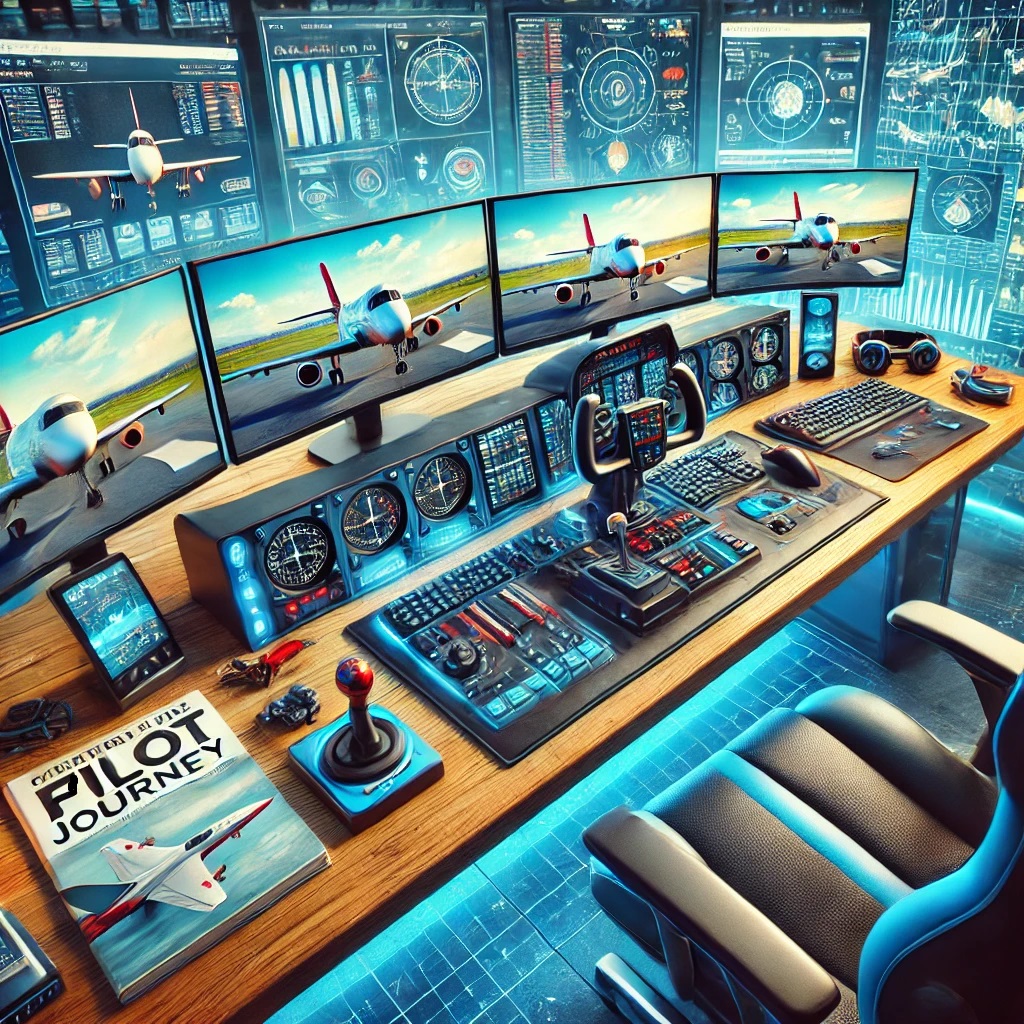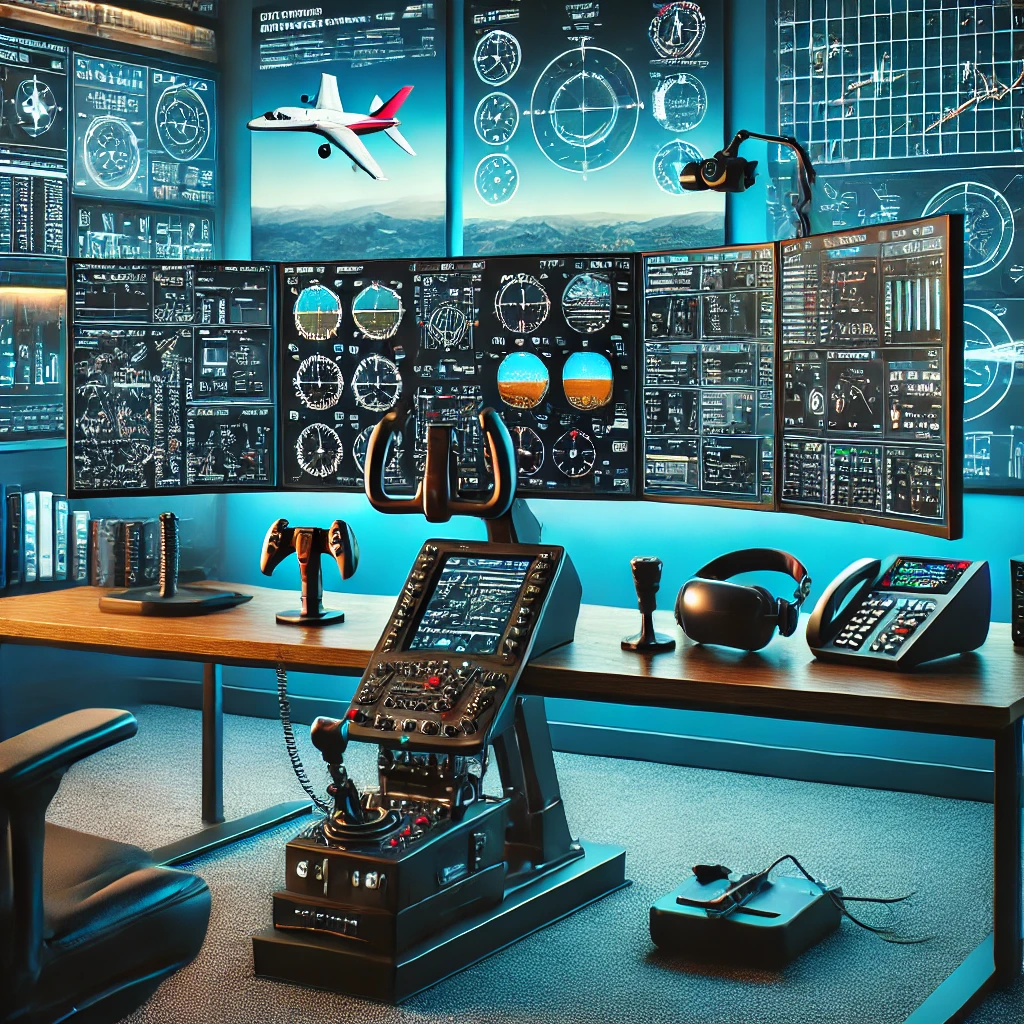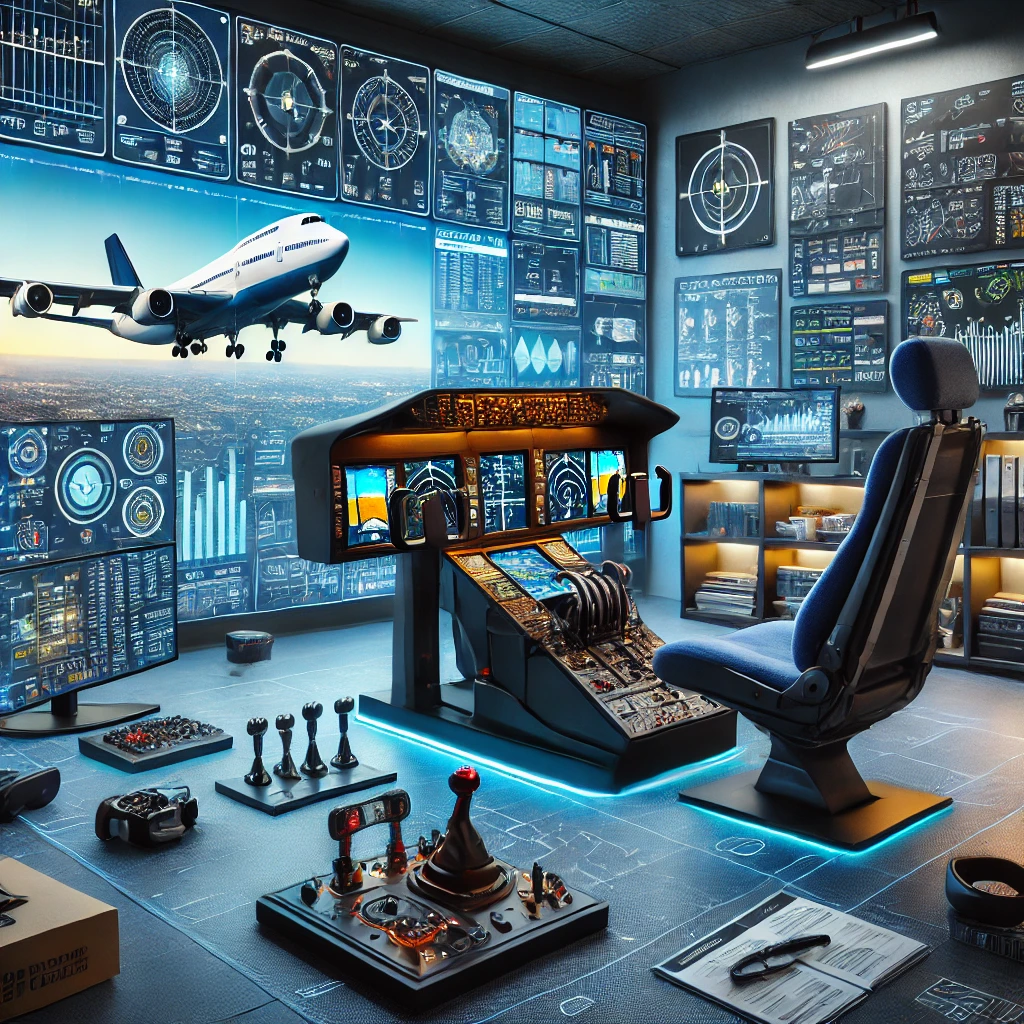Learn How to Fly with Flight Simulator – A Beginner’s Guide to Virtual Aviation:

If you’ve always wanted to take to the skies but find flight school intimidating or costly, flight simulators offer an immersive, accessible alternative. Combining cutting-edge technology with the thrill of flying, these tools turn your living room into a virtual cockpit.
Flight simulators have undergone a remarkable transformation. Early iterations were basic, akin to arcade games, but today’s advanced simulations are so realistic that even seasoned pilots use them for training. Plus, these aren’t just games; they’re packed with real-world physics and lifelike graphics that make you feel like you’re actually in the cockpit. For more on the evolution of flight simulators, explore this History of Flight Simulation.
Why are flight simulators gaining such widespread popularity? They offer a cost-effective alternative to traditional flight training, allowing you to practice essential maneuvers without the financial burden of flight hours. Plus, it’s super convenient. No need to drive to an airfield; just boot up your PC or gaming console and you’re good to go! Lastly, it’s a lot less stressful. Mess up a landing in a sim? Just hit restart and try again. No harm, no foul.
Choosing the Right Flight Simulator to Suit Your Needs:

Selecting the right flight simulator can feel overwhelming due to the sheer number of options available. However, finding the ideal fit is well worth the effort. Here’s a rundown to help you make an informed decision.
First off, let’s talk variety. You’ve got everything from basic simulators for casual flyers to hardcore setups that veteran pilots swear by. If you’re just starting, go for something user-friendly, like Microsoft Flight Simulator or X-Plane. They offer a realistic experience and tons of tutorials that’ll get you flying in no time. To learn more, visit the Microsoft Flight Simulator Official Site or the X-Plane Official Site.
For those looking to up their game, check out more specialized options like Prepar3D or some of the top-tier hardware setups. These are more detailed and offer advanced features that simulate real-world flying conditions down to a T. Perfect if you want to feel every bump and gust of wind.
Don’t forget about the gear. A decent joystick or yoke makes a world of difference. Also, check if the simulator you’re eyeing supports VR – virtual reality can turn your sim experience from awesome to jaw-dropping. For hardware recommendations, check out this Flight Simulator Hardware Guide.
And hey, let’s not break the bank here. There are fantastic flight sims for all budgets. Do a bit of research, read some reviews, and maybe watch some YouTube demos to see what catches your eye. Your wallet (and your significant other) will thank you.
Setting Up Your Home Flight Simulator:

Once you’ve selected your flight simulator, it’s time to create your home cockpit. No pilot’s license required—just a bit of space, some know-how, and the right equipment.
First things first, let’s talk hardware. You’ll need a solid computer or gaming console to run your simulator smoothly. Make sure your system meets the recommended specs. Trust me, nothing’s worse than choppy graphics when you’re trying to land a 747.
Next up, controls. A joystick or yoke is crucial for a realistic experience. Some folks even go for pedals and throttle quadrants to replicate a real aircraft setup. It’s all about what feels good to you.
Creating your space comes next. You don’t need a dedicated room, but a clutter-free area helps keep you focused. Think about lighting – dimmable lights or even some LED strips can set the mood and reduce glare on your screen.
Now, software tweaks. Adjusting settings within your simulator enhances realism. Modify sensitivity for your controls and tweak the graphics settings for the best blend of performance and visuals.
Common challenges? Yeah, they’ll pop up. Configuring your controls might take a few tries. You might also face some software bugs. Keep the manuals handy and don’t hesitate to hit online forums – the sim community is super helpful.
A comfortable chair and a good pair of headphones with a mic can make your flying sessions more enjoyable. Plus, with headphones, you can immerse yourself in the engine roars and ATC chatter without annoying your neighbors.
With these tips, you’re all set to transform your setup into a virtual cockpit. Get ready, ’cause your flying dreams are about to take off from the comfort of your own pad.
Fundamentals of Flight in a Simulator Environment:

Once your flight sim setup is ready, time to get a grip on the basics of flying. No matter how fancy your simulator, mastering the fundamentals is key.
First off, aerodynamics and flight controls. Understanding how lift, gravity, thrust, and drag work together keeps your virtual plane in the air. Your joystick or yoke replicates real-world controls like ailerons, elevators, and rudders. Practice makes perfect here, so spend some time on basic maneuvers like climbing, descending, and turning.
Next, standard flight procedures. Learn the ropes of takeoff and landing – it’s trickier than it looks. Start small with general aviation aircraft before working your way up to bigger birds. Trust me, nailing a smooth landing feels amazing.
Navigation skills come next. Flight sims are great for practicing radio navigation, using VORs (VHF Omni-Directional Range) and NDBs (Non-Directional Beacons). Figuring out how to follow a flight plan, stay on course, and communicate with virtual Air Traffic Control (ATC) takes your experience to a whole new level. For more details on radio navigation, refer to FAA’s Pilot’s Handbook of Aeronautical Knowledge.
Instrument flying is another biggie. It’s all about reading your cockpit instruments to fly when you can’t rely on visual cues, like in bad weather. Focus on mastering your Attitude Indicator, Altimeter, and Airspeed Indicator, along with all the other dials and screens in your virtual cockpit.
Flight training exercises help solidify these skills. Practice makes perfect, right? Many flight sims come with built-in tutorials and missions that take you step-by-step through each stage of piloting, from taxiing on the ground to executing a flawless landing.
Advanced Techniques and Skills Development:

After mastering the fundamentals, you can elevate your flying skills by exploring advanced techniques. Flight simulators truly excel in this area, offering challenges that test even experienced pilots.
Mastering weather conditions is a good place to start. Simulators let you fly through thunderstorms, heavy snow, and fog, helping you learn how to handle tricky situations. Practicing these scenarios can make you a more confident and capable pilot.
Emergency scenarios add another layer of realism to your training. Engine failure, instrument malfunction, bird strikes – flight sims let you experience these without any real-world risk. Working through these emergencies helps improve your decision-making skills and keeps you sharp.
Cockpit resource management (CRM) is another key skill. This involves effectively using available resources, like instruments, charts, and even virtual co-pilots, to ensure a smooth and safe flight. Managing these in a simulator can prepare you for real-flight teamwork and efficiency.
Advanced navigation techniques, like using GPS and autopilot systems, can also be practiced in a simulator. You’ll find this hugely beneficial when planning cross-country flights or flying in unfamiliar territories.
Finally, try simulating real-world flying experiences. Use actual flight plans, replicate flights from your favorite airlines, or even simulate specific routes and schedules. This kind of practical application boosts your skills and makes your sim experience even more rewarding.
Transitioning from Simulator to Real Cockpit: What You Need to Know:

Making the jump from a flight simulator to a real airplane is thrilling but remember, it’s a whole different ball game. While simulators are fantastic for practice, there are a few things to keep in mind.
First off, understand the benefits and limitations of simulator training. It’s a great way to hone skills and build confidence, but a sim can’t replicate the physical sensations of flying. Real cockpits have vibrations, noises, and even smells that a virtual setup just can’t mimic.
Simulator hours can be valuable, but you need real flight hours to become a licensed pilot. Make sure you log your practice, as some aviation authorities might consider sim hours towards your required training time. However, always check with your flight school or regulatory body.
Ground school is another step in your journey. Learning the theory behind flying, studying aerodynamics, and understanding aviation regulations provide a strong knowledge base. Couple this with your sim experience for a solid foundation when you start actual flight training. To deepen your theoretical knowledge, consider visiting AOPA’s Learn to Fly Resource.
Consider scheduling a discovery flight with a flight school. This initial flight gives you a taste of handling a real aircraft and can help you decide if pursuing a pilot’s license is right for you. It’s a great way to connect your simulator practice with the real world.
Hearing from others who transitioned from sim to cockpit is inspiring. Many pilots started their journey with flight simulators and went on to earn their wings. Their stories can provide motivation and practical tips on what to expect.
Taking these steps will help bridge the gap between your virtual training and actual flying. With dedication, practice, and a good plan, you can move from desktop pilot to real-world aviator.

This sounds very interesting a also a lot of fun – albeit with a serious side.
I guess this would be very useful additional training and skill development for someone who actually wanted to go through pilot training to actually fly for real.
A simulator can never replace real hands on experience inside the cockpit, but it’s great to see that budding pilots can now do their simulator training from the comfort of their own home and, in so doing, save themselves an awful lot of expense.
Which aircraft types can be simulated on this package? Is there a package for military aircraft?
Aircraft types are Boeings, Cessna, Beechcraft, Mcdonnell Douglas DC 3, Piperjet and a lot more. Yes there is Military jet F/A -18 in Flight Simulator X program. Of course Flight Simulator can advance your skill but it is not replacement for flight school.
I can imagine that this is a lot of fun to play with and that you would build some great practical knowledge of the console controls through a bit of study and repetition. What a great way to also gain the basics in flight, especially if you were planning to do lessons for real. It can be so expensive to learn to fly and I think this simulator is an amazing practice simulator. I’m sure budding pilots will gain confidence by playing this game and even better you can do it at home.
Thanks for visiting my website and thanks for the nice comment.
Good to know there is an opportunity for the newbie potential pilots to learn and acquire new skills from here! What an interesting and helpful innovation! Certainly, the budding pilots will, of course, learn more skills while studying from the comfort of their homes! Even though a simulator isn’t as effective as real hands in the cockpit, it at least makes it possible for budding pilots to stay Indoors and learn all the skills at home.
Thanks for the feedback.
Hello there! This is an informative post. I was a huge gamer back in the day (maybe 7 years ago), not so much these days. But now that I am at home more, I have been looking to get back into some gaming just to keep me from getting bored. I haven’t thought of trying out flight simulation games before. Seeing some of the images on your post, it looks really complicated. Glad to hear that the Flight Simulator program has a flight lesson tutorial. Otherwise I can confidently say I would crash my plane. Definitely not a good start for becoming a pilot. Thanks for creating this post!
You are welcome. I have to take a screenshot of the game and edit it using paint program and then post it in my website.
Thanks for sharing a great article to learn more about how to fly with flight simulator, I never thought this could be possible, but it sounds like a great fun, I always wonder how pilots manage to fly planes and this could help me to learn a little about it, as it sounds interesting and fun, I might give it a try.
Thanks for the feedback. Pilot manage to fly planes by following the training on Flight Simulator lessons before flying an actual aircraft.
Hello MElamin,
I can feel deeply now that learning how to fly a plane is not easy. You can’t just jump in and start flying. In order to be a pilot, you need to have a lot of training and experience. That’s why it’s so important that people have the opportunity to learn how to fly with flight simulator.
Flight simulation are a great way for people who want to become pilots but don’t have the time or money for training, or who live in areas where there aren’t any flight schools, the opportunity to learn how to fly without putting themselves at risk of crashing an actual airplane.
I’m so grateful that am not pilot. lol.
Have great weekend.